Comparing Alligators and Crocodiles
Alligators and crocodiles are massive reptiles that look a lot alike. They ought to because they’re close relatives. Even though they’re from different families, they’re both members the order “Crocodilia.” Consequently, in an area where their territories overlap, it might be hard to decide which one you’re looking at. However, there are 15 major differences between Alligators and Crocodiles that I’ll explain in this article. This will help you differentiate between the two species. We’ll also go over 9 things that alligators and crocodiles have in common.
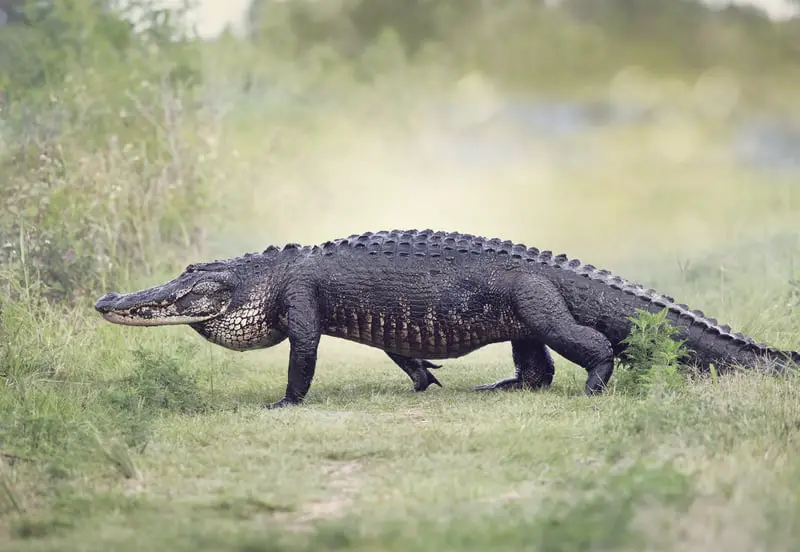
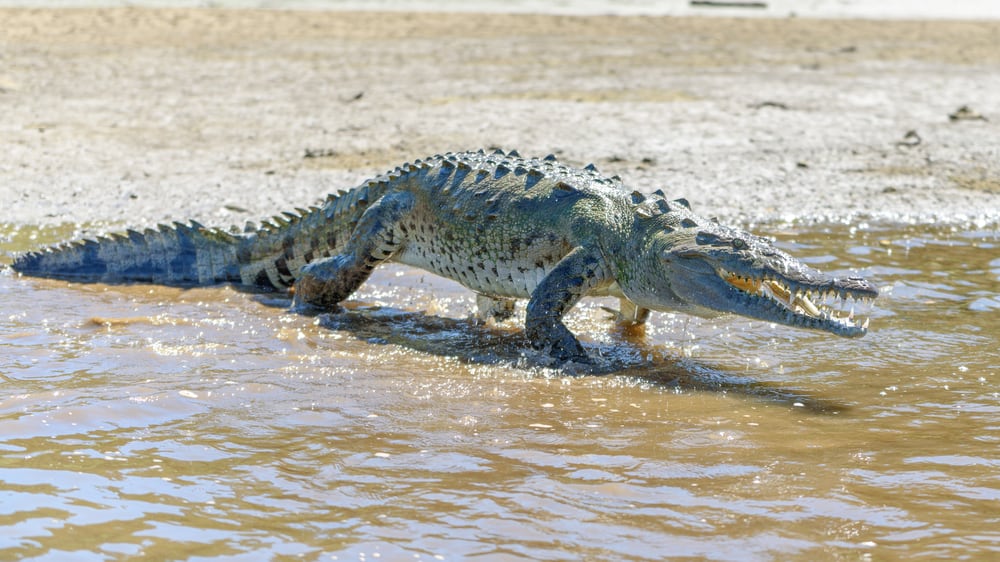
You Can See Both Alligators and Crocodiles in Florida
When you’re in the wetlands of south Florida, you’re in alligator combined with crocodile habitat. Some of you are asking, “Are there crocodiles in Florida?!” The answer is yes. The Florida everglades on the Southern tip of the Florida peninsula are home to both American Alligators “Alligator mississippiensis” and American Crocodiles “Crocodylus acutus.” It’s the only place on the planet where alligators and crocodiles live together. Consequently, it’s a place where you can go to try the skills that you’re going to learn below at telling the two creatures apart.
Alligator vs Crocodile Color … Alligators are darker.
There are variations, but most of the time, Alligators are dark grey or even black. On the other hand, crocodiles are light tan to olive green-colored.
To a certain extent, though, their environment has a modifying effect on their color. For example, water with a heavy algae load will make their skin greener. On the other hand, tannic acid from plants that overhang the water makes their skin darker colored.

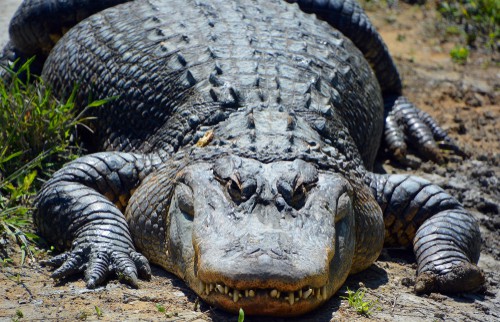
Alligator vs Crocodile Snout Shape … An alligator’s is U shaped. A crocodile’s is shaped like a V.
The shape of their snout is a good indicator of whether you’re looking at an alligator or a crocodile most of the time.
An alligator has a rounded snout that is flatter and broader than a crocodile’s. If you look at an alligator’s snout from above, you’ll notice that it’s rounded and almost U-shaped. Most species of crocodiles have a V-shaped snout that is narrow at the tip and wider at the base.
Mugger Crocodiles which inhabit lakes, rivers, and swamps in Pakistan, India, Iran, Nepal, and Sri Lanka, are an exception to the rule. They have broad U-shaped snouts, much like alligators but share many other characteristics in common with Crocodiles.
Nile Crocodiles also have a broader stout than most crocodiles.
Alligator vs Crocodile Size … On average, crocodiles are bigger than alligators.
American Alligators “Alligator mississippiensis,” which live in the southern United States from east Texas to North Carolina and south to Southern Florida, can attain lengths of 11 to 15 feet and weigh up to 1000 pounds. The largest American Alligator ever recorded was 19 ft. and 2 inches long. Chinese Alligators “Alligator sinensis,” which live in eastern China, are about half the size of their American cousins.
There are size variations between the 14 species of crocodiles. The largest crocodile species are several feet longer than American alligators and outweigh them by over 1,000 pounds. On the other hand, some crocodile species are smaller than the American Alligator and are even smaller than the Chinese Alligator.
| Alligators | Alligator Size |
|---|---|
| American Alligator “Alligator mississippiensis” | American Alligators can attain lengths of 11 to15 feet and weigh up to 1000 lbs. |
| Chinese Alligator “Alligator sinensis“ | Chinese Alligators can attain lengths 5 to 7 feet and weigh up to 80-100 lbs. Source |
| Crocodiles | Crocodile Size |
|---|---|
| Saltwater Crocodile “Crocodylus porosus“ | Saltwater crocodiles live in Australia, southeast Asia, and Oceana. Among crocodilians, they’re the largest species. Males can be up to 20 feet (6 m) long and weigh 2200 to 2900 pounds (998 to 1315 kg). An Australian government-sponsored study has concluded that there are specimens out there that are up to 23 ft. (7m) long and weigh over 4,000 pounds (1814 kg). |
| Nile Crocodile “Crocodylus niloticus“ | Nile Crocodiles live in Africa. They’re the second-largest crocodilian species behind Salt Water Crocodiles. On average, they weigh around 1100 pounds (499kg) and are 12 feet (3.65) long. However, they can be over 20 ft. (6.1 m) long and weigh over a ton (907 kg.). |
| American Crocodile “Crocodylus acutus“ | American Crocodiles live in North America, Central America, and South America. Male American Crocodiles can be up to 20 ft. (6.09 m) in length and weigh up to 2,000 pounds (907 kg). On average, though, they are 9 to13 ft. (2.74 to 4 m) in length. Females are up to 12 1/2 ft. in length. |
| Orinoco Crocodile “Crocodylus intermedius“ | Orinoco Crocodiles live in South America. Male Orinoco Crocodile specimens have been recorded over 22 ft. (6.7 m) in length in the past. However, they don’t live long enough to attain such huge sizes in today’s environment. Today, you would expect a large Orinoco Crocodile male to measure 13 1/2 to 17 ft. (4.11 to 4.18 m) and weigh up to 840 pounds ( 381 kg). |
| Mugger Crocodile “Crocodylus palustris” | The average size for a male Mugger Crocodile is 10 ft. (3 m). Some specimens can be quite a bit larger. Old Mugger Crocodile males can be up to 18ft. (4 1/2 m) long and weigh 1000 pounds (450 kg) |
| African Dwarf Crocodile “Osteolaemus tetraspis“ | African Dwarf Crocodiles live in sub-Saharan west Africa and Central Africa. They’re the smallest species of crocodiles. On average, they are 4.9 ft. (1 1/2 m ) in length. The maximum recorded length for an African dwarf crocodile was 6.2 ft. (1.89 m). The Largest African Dwarf Crocodile adult males weigh 180 pounds (80 kg.). |
| Fresh Water Crocodile “Crocodylus johnstoni” | Freshwater crocodiles live on the Australian Continent. Male Freshwater Crocodiles can attain lengths of 7 1/2 to 10 ft. (2.3 to 3 m). Female freshwater crocodiles reach a maximum length of 6.9 ft. (2.1 m) |
| Cuban Crocodile “Crocodylus rhombifer“ | Cuban Crocodiles live on the island of Cuba. They grow up to 10 1/2 ft. (3.5 m) long. |
| Morelet’s Crocodile “Crocodylus moreletii“ | These crocodiles live in central America. Adult Morlete’s Crocodiles can attain a length of about 10ft. (3 m). |
| Siamese Crocodile “Crocodylus siamensis“ | Large Siamese Crocodile males reach a maximum of about 13 ft. (4 m) in length and weigh up to 770 lbs. (350 kg). Females measure up to 10 ft. (3.2m) and weigh up to 330 lbs. (150 kg ). |
| Philippine Crocodile “Crocodylus mindorensis“ | Philippine Crocodiles live in the Philippines. Males of this species grow up to 10ft. (3 m), and females are smaller. |
| African Slender Snouted Crocodile “Mecistops cataphractus“ | Slender Snouted Crocodiles live in west and central Africa. They are divided into two distinct species: the West African slender-snouted crocodile and the Central African slender-snouted crocodile. The data we’re using on these animals comes from the Oregon zoo. They attain lengths of up to 13 ft. long ( 3.96m) and weigh up to 500 lbs ( 227 kg.). |
| New Guinea Crocodile “Crocodylus novaeguineae“ | The New Guinea crocodile lives in New Guinea. Males of this species grow up to 11 ft. (3 m) in length. Females get up to 8.9 ft. (2.7m). |
| West African Crocodile “Crocodylus suchus“ | These animals live in west and central Africa. Adult West African Crocodiles range from 5 to 8 ft. (1.5 to 2.5 m) long. They can get up to 13 ft. (4 m) long in the extreme. |
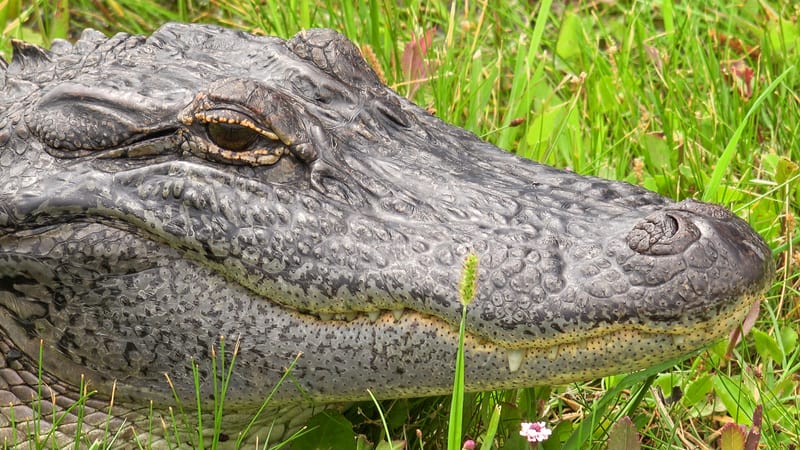
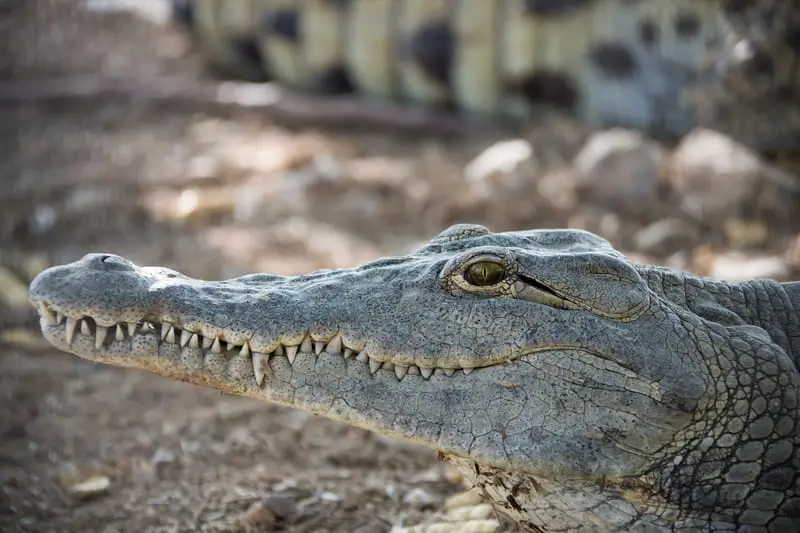
Alligator vs Crocodile Jaw Structure … A crocodile’s bottom teeth are visible when their mouth is closed.
You can only see an alligator’s downward-pointing upper teeth when its mouth closes. Its lower teeth are almost completely hidden. This is because an alligator’s upper jaw is slightly larger than its lower jaw and its bottom teeth fit inside slots in its upper jaw when its mouth is shut. On the other hand, a crocodile’s jaws are pretty much in line, and its top teeth fit over its lower lip while its lower teeth fit over its upper lip. Its upper and lower teeth mesh together when its jaws are closed. This gives the crocodile its trademarked toothy grin. This is particularly true of the large fourth tooth that protrudes from each of a croc’s lower jaws. That fourth tooth fits into a socket in the upper jaw on an alligator. This isn’t so with a crocodile. A crocodile’s fourth tooth is prominent and obvious.
Alligator vs Crocodile Teeth … Alligators have more.
Alligators have 74 to 80 teeth. On the other hand, Crocodiles have 60 to 72.
Alligator vs Crocodile Feet … Alligators have 4 webbed feet. Crocodiles have 2
Alligators have webbed front and back feet, while crocodiles only have webbed back feet. This gives alligators a big swimming speed advantage over crocodiles. Click here for a comparison of how fast each species is in the water.
Another difference is that Crocodiles have a jagged fringe of scales on their hind legs down to their feet, while alligators do not.
Alligator vs Crocodile Legs… Crocodiles have longer humerus and femur bones than alligators.
Crocodiles tend to have proportionately longer humerus Bones in their Forelegs and longer femurs in their hind legs than alligators.
According to a 2018 study cited by the New York times done at Hokkaido University in Japan, the differences are small and difficult to recognize in the field. Nevertheless statistically, this is the case.
The findings of this study were published in the March 8th, 2018, edition of Royal Society Open Science.
Alligator vs Crocodile Ability to Live in Saltwater … Crocodiles can live in saltwater. Alligators can’t.
Can alligators live in saltwater? The answer is no. Alligators tend to live in freshwater marshes. Their bodies are not designed to live in saltwater. Interestingly, some of them go to the ocean to hunt for food. They can survive at sea for up to a couple of days, but they have to return to freshwater habitats to live. Their bodies aren’t equipped to live in a salty environment. If they take in too much saltwater, the sodium chloride concentration in their blood will become too great. This, in turn, will cause water to be drawn from their cells to compensate for the created imbalance. They will eventually die of dehydration.
When alligators hunt in saltwater environments, they utilize a protective palatal valve at the back of their throat to keep them from swallowing saltwater. They also have protective valves in their nostrils and ears to help keep the water out during dives.
Additionally, when they swallow food that they’ve caught, they have to raise their heads out of the water to avoid taking in too much saltwater.
Can crocodiles live in saltwater habitats? The answer is yes. Crocodiles are at home in salt or brackish water environments in addition to freshwater areas. They can live in saltwater because they have specially adapted lingual salt glands. Pores manifest this at the back of their tongues that excrete excess salt from their bloodstream. This allows them to maintain the ideal salt to water balance in their bodies.
Crocodiles, sea turtles, marine birds, sea snakes, marine iguanas, sharks, rays, and skates are all examples of creatures that regulate the salt in their bodies with salt glands.
Alligator vs Crocodile Tolerance to Cold … Alligators can live in colder climates than crocodiles
Alligators can live in colder climates than crocodiles can. The only place that American Crocodiles live in the United States is the southern end of the Florida peninsula. The furthest north that they’ve been documented to live is Tampa Bay. They cannot live in temperatures any colder than what they have there.
On The other hand, American Alligators also live in the southeastern United States, but they live as far north as Gates County, North Carolina.
The yearly mean temperature at Tampa Bay, Florida, is 74 degrees Fahrenheit. At the same time, the mean temperature at Gatesville, North Carolina (Which is the county seat of Gates County) is 60 degrees Fahrenheit.
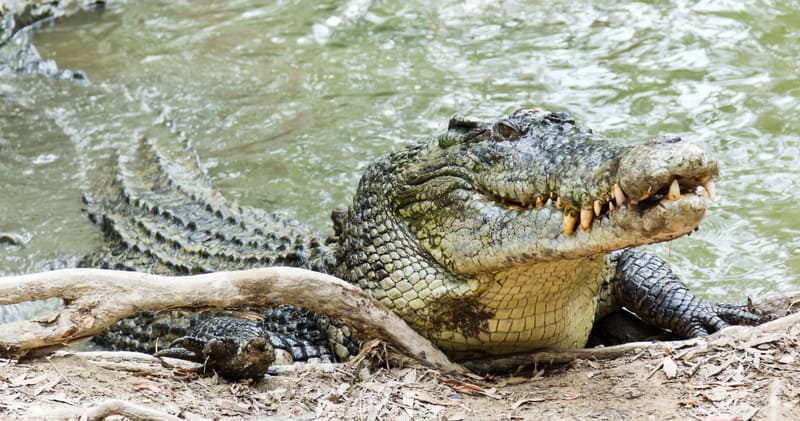
Alligator vs Crocodile Temperament … Crocodiles are more dangerous than alligators.
There are variations between species but generally speaking, crocodiles are more aggressive towards humans than are alligators. They attack hundreds of people per year. Although exact data is hard to come by, the WORLDWIDE CROCODILIAN ATTACK DATABASE estimates that crocodiles are responsible for around 1000 human fatalities per year.
Although there are more than just two guilty species, most fatal crocodile attacks on humans are perpetrated by either Saltwater Crocodiles or Nile Crocodiles.
These two are generally considered to be the most dangerous crocodilian species. Some attacks and fatalities go unreported in the areas that Nile Crocodiles inhabit, particularly in Sub-Saharan Africa. This makes obtaining exact numbers problematic.
American Alligators rarely attack humans, but they are aggressive towards people occasionally. They’re considerably less aggressive than most crocodile species, though.
A study completed in 2010 looked at reports of adverse encounters between humans and American Alligators from 1928 through January 1st, 2009. It found that in those 81 years, there had been 567 alligator on human attacks. Twenty-four of those resulted in fatalities.
There are timid types of crocodilians and Chinese Alligators that fit into this category. They are considerably less dangerous than American Alligators. There are no documented fatal Chinese Alligator attacks on humans.
Alligator vs Crocodile Life Expectancy … On average Crocodiles live longer than American alligators.
The average life expectancy across all the crocodile species is 54 years. On the other hand, the average life expectancy for alligators is 50 years for American and 70 years for Chinese respectively. A comparison of the life expectancy of alligators to crocodiles varies with each species. Alligators have a longer life expectancy than some crocodile species and a shorter one than some others.
Below is a comparative table of Crocodilian life expectancies. Scientists estimate the age of wild specimens through the analysis of bone growth rings. Bone rings are believed to be annual, but the study is still ongoing.
| Alligators | Alligator Life Expectancies |
|---|---|
| American Alligator “Alligator mississippiensis” | The average life expectancy of an American Alligator is 50 years. source |
| Chinese Alligator ” Alligator sinensis” | A Chinese Alligator’s life expectancy is 70 years. source |
| Crocodiles | Crocodile Life Expectancies |
|---|---|
| West African Crocodile “Crocodylus suchus“ | West African Crocodiles have a life expectancy of about 45 years in the wild. source |
| New Guinea Crocodile ” Crocodylus novaeguineae“ | The life expectancy for a New Guinea Crocodile is 24 years source |
| Orinoco Crocodile “Crocodylus intermedius” | The average life expectancy of an Orinoco Crocodile is 70 to 80 years. source |
| Cuban Crocodile “Crocodylus rhombifer” | Cuban Crocodiles live up to 70 years. source |
| Nile Crocodile “Crocodylus niloticus“ | Nile Crocodiles live 70 to 100 years in the wild. source |
| Saltwater Crocodile “Crocodylus porosus” | Saltwater Crocodiles live an average of 70 years. |
| American Crocodile “Crocodylus acutus“ | American Crocodiles live up to 70 years. Source |
| Mugger Crocodile “Crocodylus palustris” | The average lifespan of a Mugger Crocodile is 44 years Source |
| Morlet’s Crocodile “Crocodylus moreletii” | Morlet’s Crocodiles live for 50 to 65 years. source |
| Siamese Crocodile “Crocodylus siamensis” | Siamese Crocodiles can live up to 22 years. source |
| Philippine Crocodile “Crocodylus mindorensis” | Philippine Crocodiles can live as long as 70 years. source |
| Freshwater Crocodile ” Crocodylus johnston” | Freshwater crocodiles can live up to 50 years. source |
| Slender-snouted Crocodile “Mecistops cataphractus” | Slender-snouted crocodiles live up to 38 years source |
| African Dwarf Crocodile ” Osteolaemus tetraspis“ | African Dwarf Crocodiles live from 50 to 100 years source. |
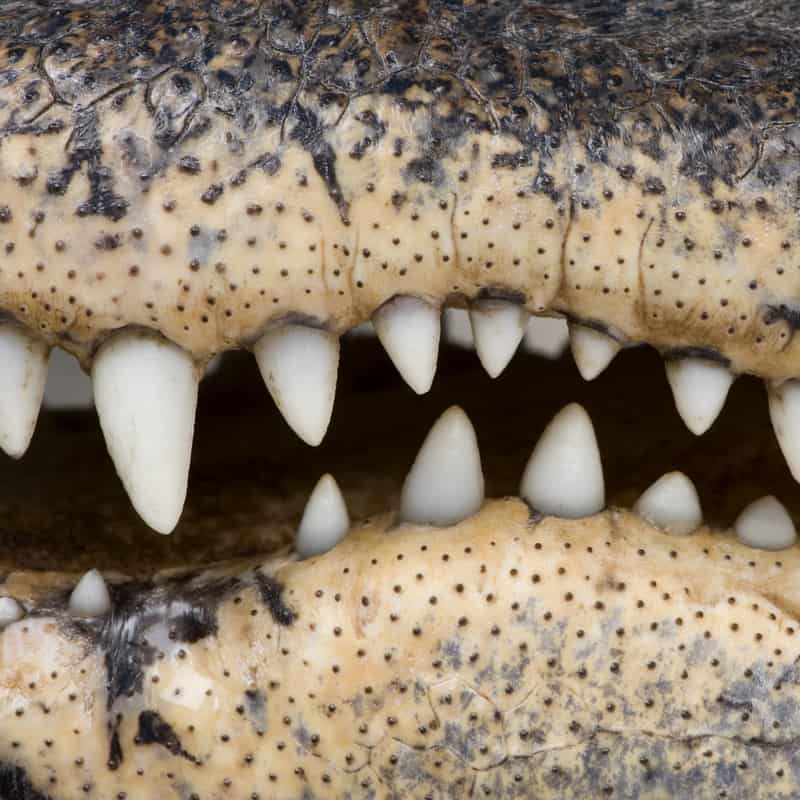
Alligator vs Crocodile Location of DPRs … Crocodiles have them all over their bodies. Alligators, just around the mouth.
Both Alligators and crocodiles have integumentary sense organs or ISOs that look like tiny dots on their skin. On crocodilians, these ISO dots are called dome pressure receptors or DPRs. They are sensory organs with a primary function which is to detect small pressure changes created in the water surrounding them by other animals. According to researchers at the University of Geneva, DPRs also detect temperature and chemical variances in the water.
Alligators have DPRs on their upper and lower jaws, around their noses, and on their upper palate. On the other hand, Crocodiles have DPRs located all over their bodies.
When people distinguish between crocodile and alligator/caiman leather, they look for the presence or the lack of DPR dots.
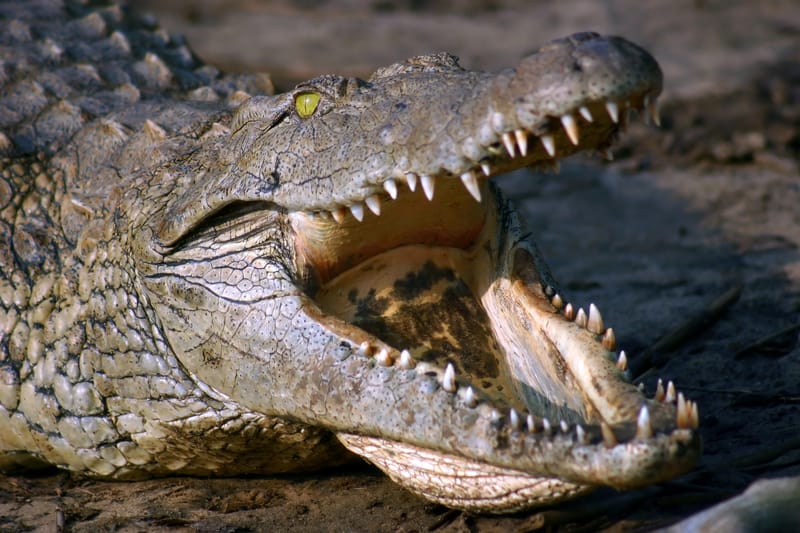
Alligator vs Crocodile Bite Force … Crocodiles bite harder than alligators do.
Alligators have bone-crushing bite force, but crocodiles have an even more powerful bite. In a study done at Florida State University, American Alligators registered an average bite force of 2980 pounds per square inch or (psi).
The only animal to top this in this study was the saltwater crocodile. They registered an astounding bite force of 3700 psi.
A saltwater croc’s bite force of 3700 psi is formidable. However, there’s another crocodilian out there with an even more powerful bite force. Nile crocodiles have the strongest bite force in the animal kingdom. They can bite with an astronomical force of up to 5000 lbs psi. This was documented on Nat Geo Wild’s Dangerous Encounters With Brady Barr.
Alligator vs Crocodile Nest Structure … Alligators use vegetation. Crocodiles use sand.
Alligators build elevated nests on dry ground out of waterside vegetation to lay their eggs in.
On the other hand, crocodiles bury their eggs in the sand. Sometimes their nests consist of mounded up sand, and other times they simply dig holes to bury their eggs in.
Alligator vs Crocodile Speed … Alligators are faster in the water.
The two animals would run a tie race on land. Both species can move quickly on land for short distances. However, they’re both better suited for life in the water. With their webbed feet, alligators hold an advantage here, though. Alligators are faster swimmers than crocodiles.
Alligators can swim up to twenty miles per hour (32 kph), while their maximum speed on land is 11 miles per hour (18 kph).
Crocodiles’ maximum speed on land is 11 miles per hour (18kph). They can swim up to 12.5 miles per hour or (20 kph).
What Do Alligators and Crocodiles Have in Common?
Both are Large Semi Aquatic Reptiles That Stem from the Order Crocodylia
The order Crocodylia comprises large predatory lizard-like reptiles that live both on land and in the water. Three families make up the Crocodilian order: Alligatoridae, Crocodylidae, and Gavialidae.
The two species of Alligators stem from the Alligatoridae family, along with six species of caiman.
On the other hand, the thirteen species of crocodiles stem from the Crocodylidae family.
Both are Ambush Predators that Stalk Their Prey in or From the Water
Both Alligators and Crocodiles have their eyes placed at the very top of their heads. Their nostrils are also placed on top of their snouts, aiming upwards. This allows these creatures to stay submerged with only their eyes and their nostrils showing above the surface of the water.
This adaptation allows them to lie in wait for prey animals to come close enough for them to attack.
The two creatures both eat fish, birds, and small mammals. Large alligators are capable of taking down animals as large as deer. Some mature crocodiles can take down even larger prey.
Both Species Have Their Gender Determined by the Temperature Their Eggs are Incubated At
All crocodilians have Temperature-dependent sex determination (TSD). This is a trait they share with most turtles, plus some fish and lizard species.
If crocodile eggs are incubated at 89.6 to 91.4 degrees Fahrenheit (32-33 Celsius), the resulting offspring will be males. Temperatures above or below this range will result in females.
On the other hand, American Alligator eggs incubated at 34 ºC (93.2 ºF) and above will produce primarily males, while incubation at or lower than 30 ºC (86ºF) produces mostly females.
Both Have Four Chambered Hearts
Most reptiles have hearts with three chambers. Only members of the order Crocodylia have four-chambered hearts. This adaptation, along with others, enables them to separate oxygenated and unoxygenated blood more efficiently when submerged for extended periods of time.
Both Can Stay Under Water for a Long Period of Time Without Surfacing to Take a Breath
On an average dive, alligators stay underwater from 15 to 30 minutes before coming up for air. However, they can remain submerged for up to twenty-four hours if conditions are right.
Crocodiles generally stay submerged for 10 to 15 minutes. However, they can stay underwater for up to a half-hour if they are hiding from a threat.
Both are Ectotherms
Both alligators and crocodiles are cold-blooded. In other words, they cannot regulate their body temperatures internally. This is a trait that they share with all other reptiles. Alligators, crocodiles, and other crocodilians alternate time basking in the sun or staying submerged in the water to regulate their body temperatures externally.
Both Can Go for Long Periods of Time Without Eating
Crocodiles and alligators have very slow metabolisms since they don’t use energy to regulate their body temperatures internally.
In an average year, a crocodile will eat 50 meals. However, they can go over a year without eating in extreme circumstances.
In arid climates, crocodiles may enter a period of aestivation. Aestivation is unlike hibernation in that it is entered into as a response to hot and dry conditions, not cold. During aestivation, crocodiles enter caves or burrows to wait out the adverse conditions. In some cases, they’ll encase themselves in a mud cocoon with only their snout poking out. A crocodile can go for up to two months without drinking water and up to two years without eating in this state.
Alligators usually feed once a week, but like crocodiles, they’re capable of going over a year without eating.
During the winter, alligators enter a state of brumation. Brumation is unlike hibernation in that the animal does not slumber. However, their metabolism slows down, and they do not eat. They continue to drink, though, and on sunny days, they’ll emerge from their burrows to bask in the sun.
Both Have Nictitating Membranes, Ear Flaps, And Nostril Flaps
Alligators, Crocodiles, and all other crocodilians have nictitating membranes. These are basically transparent third eyelids. Other creatures besides crocodilians have nictitating membranes. However, in crocodilians, they close over their eye when they’re underwater and serve as a transparent eye shield when they’re diving.
Alligators and Crocodiles both also have flaps of skin in their nostrils and ear canals that seal any water from leaking in when they’re submerged.
Both Have Scutes
Both Alligators and Crocodiles, along with all other crocodilians, have scutes. Scutes are the thick armor-plated scales that these reptiles have.
Final Thoughts
I think I’ve shared some interesting facts about alligators and crocodiles. The easiest way to gain an appreciation for an animal is to learn about them. Now get out there and see some crocodilians. Just don’t get in the water with them.
Also, see “American Crocodile.”
Recent Posts
The only venomous snakes in Washington State are Northern Pacific Rattlesnakes. The Northern Pacific Rattlesnake (Crotalus oreganus oreganus) is a sub-species of the Western Rattlesnake. Anyone...
Skunks are not classified as true hibernators. But they go into a state of torpor when the weather gets cold. Skunks are light sleep hibernators, along with opossums, bears, and raccoons. ...
